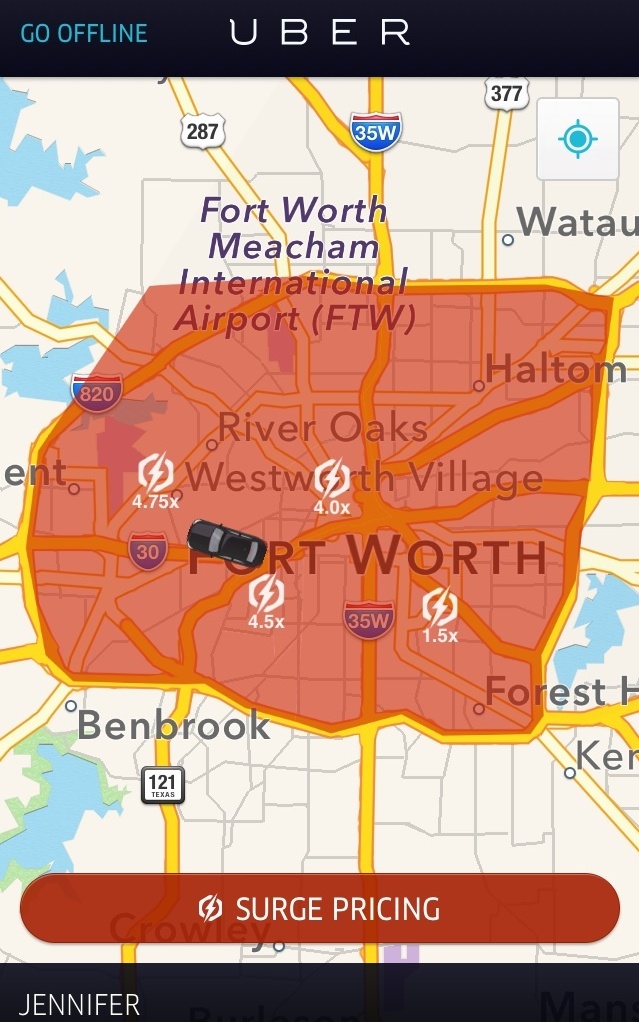Are YOU Causing an Uber Surge

Uber surges seem to be a regular hot topic on the news – whether it’s crowdfunding a high fare, the 4x fare that was charged in Sydney after the hostage situation began last week, or ways to circumvent the surge – the variability in pricing tends to rile passengers.
But it’s possible that the surge you are in the middle of might indirectly be you.
Let me explain….
Surge pricing is based on a supply/demand algorithm (which was explained well in a Time article earlier this week). But what some may not realize is that the demand part of the equation kicks in as soon as users start opening the Uber app.
The system is optimized to check the supply of drivers in concert with the number of potential riders. If it looks like demand is going to exceed the supply of drivers, the surge kicks in as a virtual “bat signal” to drivers to let them know that they are needed in a particular geographic zone. On the driver app, the area literally lights up in bright red and displays the multiplier. And typically, nearby cars go rushing to the area to respond.
Do you do any of these things?
1. Everyone in your group has their Uber app open
Why is it a problem? If there are four of you in need of one car, but everyone is checking Uber, the system thinks that four cars will be needed. Now multiply this times others in the area doing the same thing and, voila, it’s a surge.
How to fix it? Designate one person in the group to be the Uber requestor for that ride. Fewer individuals registering on Uber’s radar means less likelihood of a surge.
2. Requesting both Uber and Lyft to see which one arrives first
Why is it a problem? In many cities, the same drivers are registered with both Uber and Lyft. Drivers will accept the first ping they receive and then shut the other service down while they respond. Requesting both car services potentially takes two drivers out of service on either platform. That can mean fewer cars on the road and more likelihood of a surge.
How to fix it? Pick a service and stick with it. Or if you are trying to avoid an Uber surge, look for Lyft availability before opening the Uber app.
3. Checking Uber frequently to see if the surge has ended
Why is it a problem? This is one of the most common reasons where I will see a fare surge in a small area. Users looking to avoid the surge will repeatedly open the app (or their friends will) to see if it has ended. For the reason I gave above, this will cause demand to artificially spike and will potentially cause the surge to run even higher.
How to fix it? Uber has an option to “notify me when the surge ends” where you can elect to receive a text when pricing drops. I’ve used this as a rider to notify me of the end of a surge, although I found it difficult to sit it out and wait to see if I’d be notified as soon as it ended (I was). This helps avoid pinging the Uber server and sending a false signal for “demand” while the surge is running.
At the end of the day, the goal is to avoid sending false demand cues to the Uber servers – and in turn, to keep surges to a true shortage of drivers for demand. As a driver, it’s not fun to drive to a surge area expecting high demand only to sit idle because there are more drivers than passengers, so this is beneficial on both sides of the equation.
Interesting. I’d always assumed that a surge resulted from actual car requests exceeding supply.
I haven’t been guilty myself of any of your three scenarios, but I have opened Uber to see how near cars were or expected wait time in order to gauge what might be typical for a future day pickup for that time of day.
I think Uber should do a much better job of educating users that merely opening the app can contribute to surge pricing – your post is the first I’ve heard of that. And the Uber back end software should be smart enough to discount the false demand learning what areas and times of day have more false positives and calculating appropriately.
The foil hat crowd would say this is intentional, of course. I know the drivers get paid more during a surge, but does Uber’s cut also go up proportionally?
Thanks for the post, those are good tips on how to avoid contributing the problem.
I’m not an Uber driver, but I think Uber’s cut stays the same (percentage wise) on all rides. Jenn will probably be able to tell you what the cut is.
I like your ideas to avoid causing a surge in the first place. I have never requested an Uber and Lyft at the same time. I prefer Uber for the larger number of drivers and the transparency of the bill, along with the ample ways to generate credits with referrals and AMEX offers.
I am a frequent Uber user. I have checked to see if there is a surge at times when I wasn’t immediately going to call a ride. I had no idea that this could cause false demand and I will stop doing it. I think its despicable to call for rides from Lyft and Uber at the same time. Those people should be banned. Thanks for sharing this information.